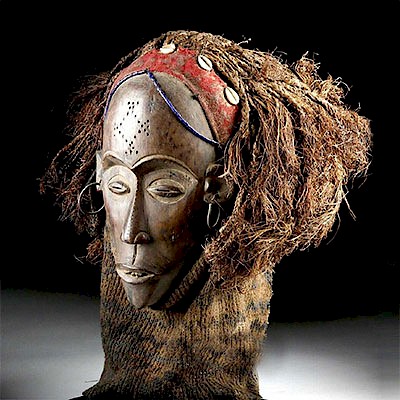18th C. Mexican Painting - Martyred St. Catherine
Lot 121b
About Seller
Artemis Gallery
686 S Taylor Ave, Ste 106
Louisville, CO 80027
United States
Selling antiquities, ancient and ethnographic art online since 1993, Artemis Gallery specializes in Classical Antiquities (Egyptian, Greek, Roman, Near Eastern), Asian, Pre-Columbian, African / Tribal / Oceanographic art. Our extensive inventory includes pottery, stone, metal, wood, glass and textil...Read more
Estimate:
$1,200 - $1,800
Absentee vs Live bid
Two ways to bid:
- Leave a max absentee bid and the platform will bid on your behalf up to your maximum bid during the live auction.
- Bid live during the auction and your bids will be submitted real-time to the auctioneer.
Bid Increments
| Price | Bid Increment |
|---|---|
| $0 | $25 |
| $300 | $50 |
| $1,000 | $100 |
| $2,000 | $250 |
| $5,000 | $500 |
| $10,000 | $1,000 |
| $20,000 | $2,500 |
| $50,000 | $5,000 |
| $100,000 | $10,000 |
| $200,000 | $20,000 |
About Auction
By Artemis Gallery
Apr 4, 2019
Set Reminder
2019-04-04 10:00:00
2019-04-04 10:00:00
America/New_York
Bidsquare
Bidsquare : Ancient / Ethnographic From Around The World
https://www.bidsquare.com/auctions/artemis-gallery/ancient-ethnographic-from-around-the-world-4003
Ancient art from Egypt, Greece, Italy and the Near East, as well as Asian, Pre-Columbian, Native American, African / Tribal / Oceanic, Spanish Colonial, Russian Icons, Fine art, much more! All categories, all price ranges... all legally acquired and guaranteed to be as described or your money back Artemis Gallery info@artemisgallery.com
Ancient art from Egypt, Greece, Italy and the Near East, as well as Asian, Pre-Columbian, Native American, African / Tribal / Oceanic, Spanish Colonial, Russian Icons, Fine art, much more! All categories, all price ranges... all legally acquired and guaranteed to be as described or your money back Artemis Gallery info@artemisgallery.com
- Lot Description
Mexico, Spanish Colonial inspired, ca. late 18th to early 19th century CE. A wonderful oil on canvas painting depicting a martyrdom scene of St. Catherine of Alexandria who was set to be executed on a device that came to be known as the Catherine Wheel for refusing to denounce her Christian beliefs. She is shown wearing a crown alluding to her royal birth with her palms pressed together in prayer while being drawn toward a wooden wagon wheel studded with iron spikes. The crowned figure underfoot may be Roman Emperor Maxentius who desired and later executed her. Miraculously, the wheel broke when St. Catherine touched it. Sadly, following this, she was beheaded. Above are two haloed holy women (perhaps Barbara, Mary Magdalene, Catherine of Siena or Ursula) kneeling in prayer before depictions of the Crucifixion; Catherine underwent a mystical marriage with Christ. Scenes of Saint Catherine's martyrdom are rare; more frequent are scenes of the mystic marriage of Saint Catherine. Size: 19.875" L x 14.625" W (50.5 cm x 37.1 cm)
Catherine of Alexandria was venerated as a Christian saint and virgin martyr, a patron of learning and education, purportedly executed by the Roman emperor Maxentius in the early 4th century CE. She is second only to Mary Magdalene in popularity when it comes to female saints. According to the Golden Legend, St. Catherine was of royal birth and known to be very wise from an early age. After becoming queen, she was converted to Christianity, baptized by a desert hermit, and experienced a mystical marriage with Christ in a vision. Emperor Maxentius was in Alexandria at this time; he desired her and tried to undermine her faith. After failing in this endeavor, he sent fifty philosophers to attempt the same. When they failed as well, Maxentius put them to the stake and created a special torture device for Catherine comprised of four wheels studded with spikes. Once bound to it, a thunderbolt struck destroying the it before it could harm St. Catherine. Her body was carried to a monastery on Mt. Sinai by angels. This monastery still claims to hold her relics.
Provenance: private Moore collection, Denver, Colorado, USA, acquired thirty years ago
All items legal to buy/sell under U.S. Statute covering cultural patrimony Code 2600, CHAPTER 14, and are guaranteed to be as described or your money back.
A Certificate of Authenticity will accompany all winning bids.
We ship worldwide and handle all shipping in-house for your convenience.
#122032Painting shows signs of age and repair. Original wooden stretcher bars. One small puncture to the canvas on upper right. Loss and repair to lower left corner. Loss to lower right corner. Old repairs to lower section visible on the verso. Canvas has receded a bit on upper periphery. Canvas on the verso has darkened with age.Condition
- Shipping Info
-
All shipping is handled in-house for your convenience. Your invoice from Artemis Gallery will include shipping calculation instructions. If in doubt, please inquire BEFORE bidding for estimated shipping costs for individual items.
-
- Buyer's Premium



 EUR
EUR CAD
CAD AUD
AUD GBP
GBP MXN
MXN HKD
HKD CNY
CNY MYR
MYR SEK
SEK SGD
SGD CHF
CHF THB
THB
















